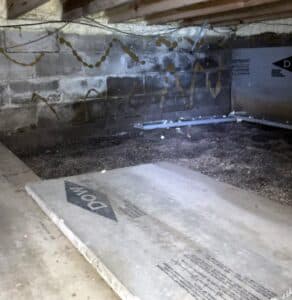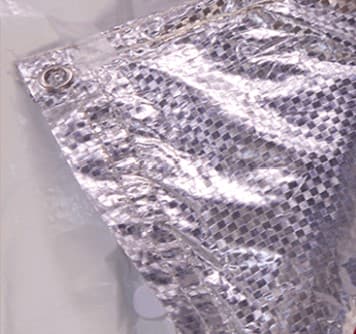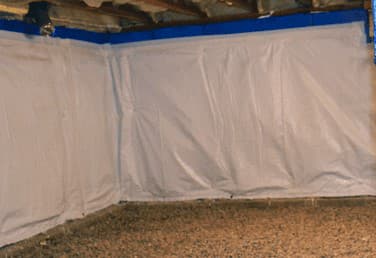[et_pb_section fb_built="1" admin_label="section" _builder_version="4.16" global_colors_info="{}"][et_pb_row admin_label="row" _builder_version="4.27.4" background_size="initial" background_position="top_left" background_repeat="repeat" hover_enabled="0" global_colors_info="{}" custom_margin="5px||||false|false" sticky_enabled="0"][et_pb_column type="4_4" _builder_version="4.16" custom_padding="|||" global_colors_info="{}" custom_padding__hover="|||"][et_pb_text admin_label="Text" _builder_version="4.27.4" background_size="initial" background_position="top_left" background_repeat="repeat" global_colors_info="{}"]
Are you paying higher energy bills but still have cold floors? Does your home have a musty smell that worsens when your HVAC turns on? These could be signs that you need to reevaluate your crawl space insulation. Choosing the best insulation for your crawl space is essential to energy efficiency, moisture control, and protecting your home’s structural integrity.
Crawl spaces are often neglected because they’re “out of sight and out of mind.” ... but the uninhabited space below your floors can impact your home’s stability, energy costs, and indoor air quality. Even worse, poor insulation - or its failure - may lead to long-term foundation issues.
Table of Contents
Acculevel is a family-owned and operated company that specializes in foundation repair and waterproofing. Since our start in 1996, we’ve helped more than 35,000 homeowners preserve and protect their home’s foundation, health, and resale value.
In this guide, we’ll explore the best insulation for a crawl space with a dirt floor, the best crawl space insulation options, and the best insulation for floor joists in a crawl space, so you can make an informed decision.
When considering the best way to insulate a crawl space, it’s important to avoid materials that absorb moisture.
Let us be clear, fiberglass batt insulation, while affordable, and a good choice for some parts of your home, it is not suitable for crawl spaces. This is due to its tendency to hold moisture, leading to mold prevention challenges and structural damage.
Spray polyurethane foam and rigid foam insulation boards are far better choices, especially in crawl spaces with high humidity levels and ground moisture. Please understand that unless a crawl space is encapsulated, it will get damp periodically. Most crawl spaces don’t have a true floor; they’re usually open to the dirt below, which allows ground moisture to intrude.

Crawl Space fiberglass insulation that has become damp, unraveled, and is falling down.
Photo taken by an Acculevel project advisor during an in-home assessment.
If you currently have fiberglass insulation in your crawl space, we advise you to have it removed and disposed of in a safe manner. Fiberglass materials are hazardous substances and cannot be tossed into your trash without precautions. Once this is done, you’ll need to inspect your floor joists, sill plate, and other wooden components for mold, decay, or insect damage.
Not sure how to properly inspect your crawl space and foundation for signs of damage? Use our free DIY Home Inspection Guide; it explains what to look for and how to detect problems.
Now that you’ve removed a potential threat to your floor’s structural integrity let’s discuss the types of crawl space insulation that will benefit you and your home.
Selecting the best crawl space insulation can drastically improve energy efficiency and protect your home from costly repairs. Among the top choices is closed-cell spray foam, known for its high R-value, moisture resistance, and ability to prevent air leaks.
For insulating crawl space walls, options like foam board insulation and blanket insulation (such as Reflectix or Radiant Armor) provide long-term protection against cold air, humidity, and pests.
While spray foam insulation may seem more expensive than fiberglass batts at first glance, the cost difference is offset by the smaller quantity needed. Spray foam effectively insulates the entire crawl space with minimal material, focusing on critical areas like joist boxes.
Most builders and contractors agree that spray foam is a far better product for use in a potentially damp environment. This rigid foam insulation repels water and is resistant to biological growth.

Sspray foam insulation in a homeowner’s crawl space.
Photo taken by an Acculevel team member after installing
Your floor joists are one of the most vulnerable parts of your home’s flooring structure. Insulating them properly with the best insulation for floor joists in a crawl space is crucial to prevent energy loss and moisture damage.
To understand why, consider how your home is built. While your foundation - made of concrete, brick, or stone - offers natural insulation, the wooden flooring structure placed above it is more susceptible to temperature changes and moisture.
The joist box, where the sill plate and band joist connect, is the most critical point for insulation. Depending on your crawl space’s depth, the area beyond the band joist could be exposed to outside air or damp soil, both of which can allow cold air and moisture to penetrate if not properly insulated.
Closed-cell spray foam is often the top choice for insulating floor joists because it provides excellent thermal resistance, seals gaps, and prevents moisture intrusion. Alternatives like foam board insulation and mineral wool also offer strong insulation properties, ensuring durability and energy efficiency for your floor joists.

This illustration is courtesy of NCSU.
Do you have more questions about your wooden flooring structure, or have you noticed sloping or sagging in your floors? We talk about flooring components and repair costs here.
The ground maintains a more constant temperature than outdoor air, but it also emphasizes the need for waterproof insulation in the joist box. If the other side of the band joist is damp soil, it’s more likely the band joist and insulation will also be in contact with moisture.
If you have a drafty crawl space, insulating the walls is essential, especially in homes with older foundations made of brick or stone. Over time, mortar can shrink and shift, creating gaps that allow cold air and moisture to seep in.
While some homeowners opt for foam board insulation on crawl space walls, it’s not always the most reliable method. Foam board is often glued in place, but on damp surfaces, adhesives can weaken and fail over time.
For more secure and long-lasting insulation, blanket insulation like Radiant Armor is a better option. This type of insulation is attached with specific fasteners and sealed with sealant tapes, ensuring it stays in place and provides consistent protection against temperature fluctuations and moisture.

Spray foam insulation is still secure in the joist boxes, but some foam board has fallen to the ground.
Photo was taken by an Acculevel project advisor during an in-home assessment.
Y
If you need to insulate your crawl space walls, blanket insulation is an effective and reliable option. As the name suggests, blanket insulation is a cloth-like material that attaches securely to foundation walls, providing consistent coverage and insulation.
A high-quality blanket insulation should have a reflective side to deflect cold air back toward the wall, improving energy efficiency. Additionally, using an inorganic material ensures that even if it becomes damp, it won’t retain moisture or promote the growth of mold, bacteria, or other harmful organisms.
Acculevel carries a type of blanket insulation called Radiant Armor. This wall insulation can be installed in any basement or crawl space, including in combination with encapsulation.

This is a close-up photo of Radiant Armor Insulation.
Blanket insulation isn’t hung like curtains or glued in place. Instead, the blanket insulation is firmly attached to the crawl space wall with specific fasteners to ensure it stays secure over time. The edges are sealed with seam tape to prevent gaps, enhancing both moisture control and energy efficiency.
This type of insulation is also tear-resistant, meaning punctures made during installation won’t compromise its durability or performance, making it a reliable choice for your crawl space insulation system.

Blue seam tape is visible around the edges; and the wall fasteners are white.
Photo of radiant armor after it's been installed in a crawl space.
There are varying opinions about the accuracy of the R-value measurement system, particularly when comparing it to overall insulation quality. However, since the North American Insulation Manufacturers Association (NAIMA) uses R-values as the standard, we’ll provide them here to help you choose the best crawl space insulation for your home.
| Insulation Type | R-Value |
|---|---|
| Fiberglass batting (between floor joists) | 2.8 - 3.9 |
| Spray Foam (in joist boxes) | 5.5 - 7.12 |
| Foam Board (applied to walls) | 3.5 - 4.2 |
| Blanket Insulation (hung on walls) | 8.73 |
Properly insulating your crawl space can significantly reduce cold air infiltration and energy loss, making your home more comfortable and energy-efficient. Installing the right crawl space insulation could be the key to lowering your energy costs and keeping your home cozy throughout the winter.
While this section isn’t about the best insulation for crawl space, it’s crucial to mention that proper insulation and moisture control go hand in hand. Even if you choose the best insulation for a crawl space with dirt floor, adding a vapor barrier is essential. This simple liner covers the ground under your home, preventing vapors, gasses, and moisture from escaping into your crawl space.
(We talk more about the importance of vapor barriers in crawl spaces in this article. )
To achieve optimal energy efficiency and moisture protection, selecting the best crawl space insulation is key. Whether you’re insulating floor joists with the best insulation for floor joists in crawl space or installing spray foam insulation and foam board insulation for walls, proper insulation ensures a stable and comfortable home.
Comprehensive crawl space insulation not only protects your flooring structure but also improves your indoor air quality and reduces energy costs. Ensuring you have the best insulation for crawl space installed, along with a vapor barrier, is the best way to safeguard your home’s foundation, energy efficiency, and air quality for years to come.
We have a comprehensive homeowner’s guide to crawl space repairs, available free of charge to anyone who has questions or concerns. This guide is designed to address everything from mold growth to foundation issues, including repair methods and costs.
Complete our online contact form or call 866-953-1501. We have helped more than 35,000 homeowners throughout Indiana and the surrounding areas preserve and protect their homes for the future.
When you contact Acculevel, we’ll make an appointment for you with one of our project advisors. They will sit down and discuss your concerns, your plans for your home, and the symptoms that you have experienced. Then they will thoroughly evaluate your home, diagnosing the problems and determining the best solution(s) for you.
Our goal is to provide you with a whole-home solution, a plan that addresses your complaints and will resolve them as efficiently as possible. We will treat your home as if it were our own, offering 5-star service every step of the way.
If you do not live in our service area, please make sure you are working with a reputable and properly insured contractor. Verify that they are accredited by the Better Business Bureau, and check their reviews from multiple sources.
You are also welcome to use our checklist of Questions You Should Ask a Contractor; please use this to protect yourself from potential scam artists and be certain you are working with a business that is the right fit for you.
[DISPLAY_ULTIMATE_SOCIAL_ICONS]
[/et_pb_text][/et_pb_column][/et_pb_row][/et_pb_section]